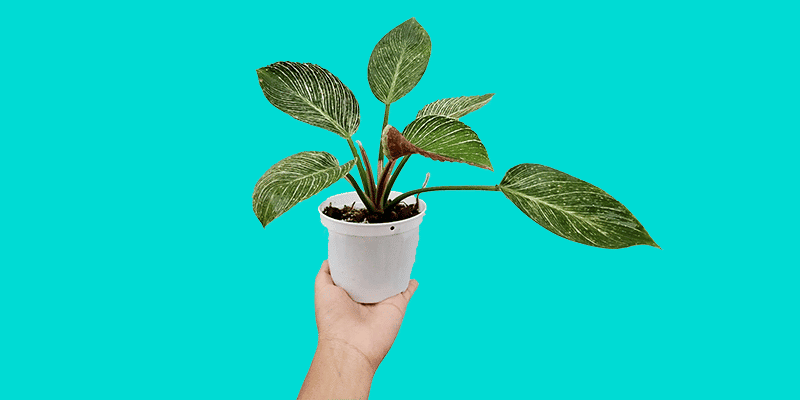If you’re looking for an indoor plant full of surprises (the nice kind!) and an interesting origin story, you’re going to love Philodendron birkin plants.
These variegated plants put out leaves full of color and pattern surprises that I can’t get enough of. You never know if you’ll get white stripes on a hunter-green background or solid red and cream blocks.
Best of all, for such intriguing-looking plants, they’re pretty easy to take care of.
In this article, I’ll cover Philodendron birkin care tips like how to keep its striped leaves vibrant, prevent it from reverting, and even how to propagate it for friends.
Table of Contents
Philodendron Birkin Care Guide
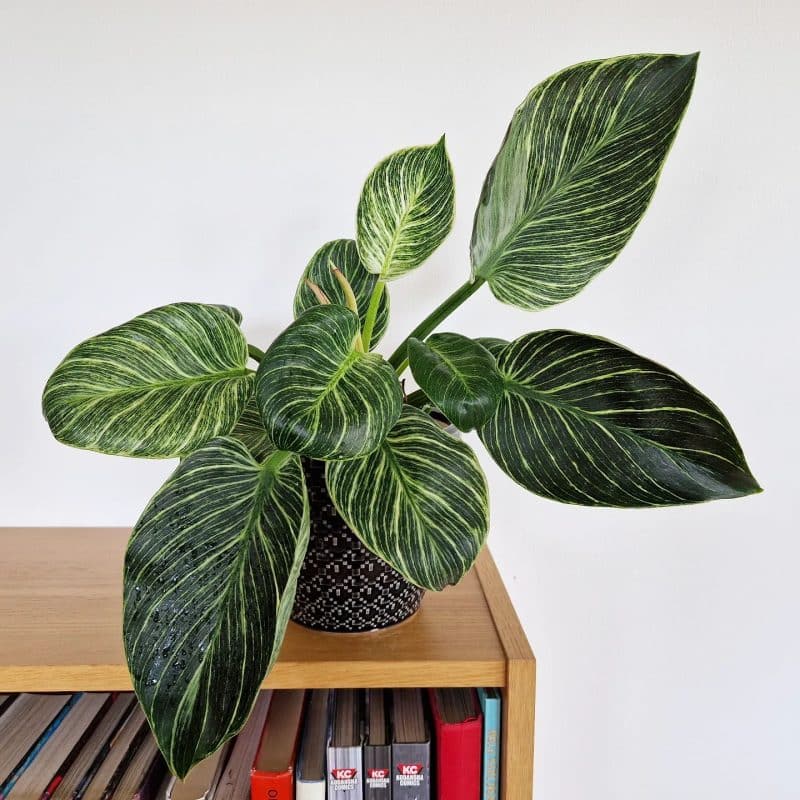
Philodendron birkin, nicknamed “White Wave,” is a slow-growing hybrid member of the Araceae family that doesn’t occur naturally in the wild. It’s the result of a rare recent plant mashup called a spontaneous chimeric mutation, or sport.
Okay, but what exactly does this mouthful mean? One cell in the Philodendron Rojo Congo (a hybrid cultivar itself) decided to mutate, and the rest of the plant’s cells followed suit. The result? The striking hybrid Philodendron birkin plant we have today.
How did the Philodendron birkin become such a widespread indoor plant? One leaf was propagated from the original plant and kept its distinct color and pattern, so garden centers knew it was a stable variation and began growing for popular consumption. Every Birkin plant you see today came from tissue culture.
“Philodendron” means “tree lover,” and some speculate that “birkin” refers to a Hermes Birkin handbag with a similar pattern. The birkin plant usually has glossy, dark green leaves with white pinstripes, although some grow cream or red-colored leaves.
Leaves are oval with tips ending in a point and can grow up to 20 centimeters long, or about 7.5 inches. The houseplant itself can grow anywhere from 50 to 100 centimeters tall, or about 39 inches.
Because this tropical plant is a hybrid, there is a possibility it could revert, or start turning into a Rojo Congo again. (I’ll cover what to do if this happens later). It could even mutate into something never seen before. Every Philodendron birkin grows with different patterns and coloring, which is part of the fun!
I’ll cover how to care for Philodendron birkin below, including grouping plants for humidity and taking stem cuttings to propagate.
(You can also compare the care & growing guide here with those we have for the micans and gloriosum Philodendron plants)
Lighting
The Philodendron birkin thrives in bright, indirect light, which is the key to producing and maintaining the white stripes it’s known for. New leaves start out white and change color as a result of how much light they get.
An east or west-facing window is an ideal location, providing enough sunlight to create vibrant stripes without burning the plant’s leaves. Wherever you put the Philodendron birkin, make sure other indoor plants don’t block its light, since it really likes to soak up sun.
It will burn in direct sunlight, however, so make sure the Philodendron birkin is at least two to three feet from windows receiving direct light. If this isn’t possible, hang a sheer piece of fabric over the window to diffuse direct sunlight.
On the other hand, if your houseplant isn’t getting enough light, you’ll see leggy growth as it reaches for the sun, and its leaves will start to lose their white stripes. In this case, consider using artificial lights or LED lights for at least 12 hours a day.
Water
Philodendron birkin watering is pretty easy – it’s a thirsty plant that needs water when the top one or two inches of soil is dry to the touch. In the spring and summer growing months, this will happen about once a week.
This plant won’t be overly sensitive to being underwatered a few times but definitely won’t fare well if overwatered. Let it dry out fully between waterings to avoid excess moisture in the soil.
Pro tip: Glazed or plastic pots will keep soil moist for longer. Ceramic or unglazed clay pots will dry out more quickly, which means a more frequent watering schedule.
Temperature and humidity
As tropical plants, Philodendron birkins don’t like to be too hot or too cold. They flourish in USDA zones 10 and 11, and grow best in temperatures of 65 to 75 degrees Fahrenheit and a humid environment of 60% or higher. To increase the humidity levels around your plant:
- Place it on a pebble tray filled with water.
- Group it with other plants so they can share humidity, a process called transpiration.
- Put it near a humidifier.
- Mist it twice a day in the spring and summer months.
Soil and planting
The soil Philodendron birkin grows best in is moist but doesn’t retain excess water. I’d recommend a soil mix of:
- 50% potting soil
- 25% spaghnum moss
- 25% orchid bark
Sphagnum moss helps soil retain water and orchid bark helps it drain – a dynamic duo! You can also consider adding bark, peat, perlite, and LECA to aid soil aeration and help its root system breathe. And remember, just like the birkin plant requires well draining soil, it also needs a pot with a good drainage hole.
Fertilize the Philodendron birkin using a balanced houseplant liquid fertilizer once a month in spring and summer and every other month in autumn and winter. You’ll see this advertised on the label as NPK, 5-5-5, or 10-10-10, which refers to all the nutrients that help the plant grow – nitrogen, phosphorus, and potassium (the k is from the neo-latin kalium).
Too much fertilizer can burn your plant’s leaves, so make it a point not to use too much or fertilize too often. A good rule of thumb is to use 1/4 to 1/2 a teaspoon of fertilizer per gallon of water.
You’ll have to repot the Philodendron birkin once every year or two, depending on how fast the plant grows. When repotting time comes around, choose a pot that’s only one or two inches larger than the current one. This will give the roots room to expand without adding more soil than necessary, which can retain too much moisture and encourage root rot.
Philodendron Birkin reverting
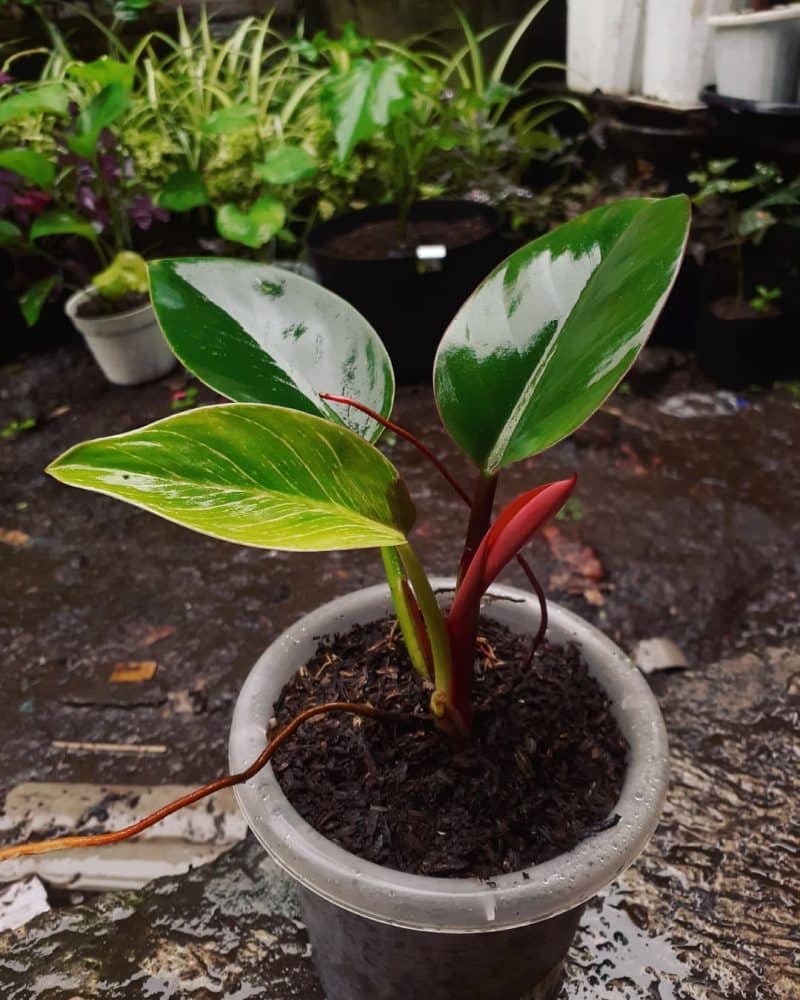
As I mentioned, there is a chance the Philodendron birkin could revert, or start turning back into a Rojo Congo, at any time. While you can choose to let this happen and get a half Rojo Congo, half Philodendron birkin leaf mix on your plant, you can also attempt to reverse the process.
Simply cut away the nonvariegated leaves until only the variegated ones remain. You’ll know your plant got the message when the next leaves that grow are variegated again in the birkin style.
Propagation guide
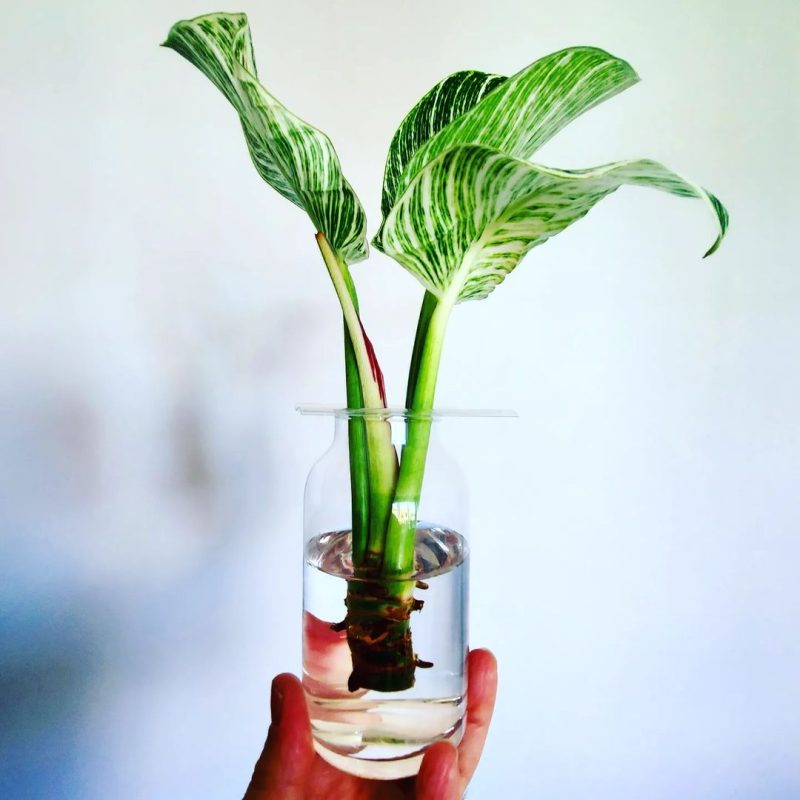
The best way to propagate Philodendron birkin is via stem cuttings. You can place them in either water or soil. Here’s how:
- Cut at least a four-inch stem section below leaf nodes (the little nubs where new leaves come from) using sterilized pruning shears or scissors. Make sure the cuttings and the mother plant keep at least two or three leaves each.
- Pluck off any leaves from the bottom of your cutting. Only the stem should touch the water or be planted into the soil in the next step.
- Put the Philodendron birkin cutting into water or right into a moist soil mix made for aroids. You can even use the same pot as the original plant if you want to conserve space. If the mix retains moisture but doesn’t remain drenched, you’ll know it’s working as intended.
- Place the jar of water in a humid location receiving bright light.
- Put your Philodendron birkin in soil once it has one or two inches of roots if using a water propagation, which should take a week or two in the growing season.
If it’s in soil already, you should see new leaves forming shortly. Be patient if you’re propagating in the winter months, since new growth can take longer during this time.
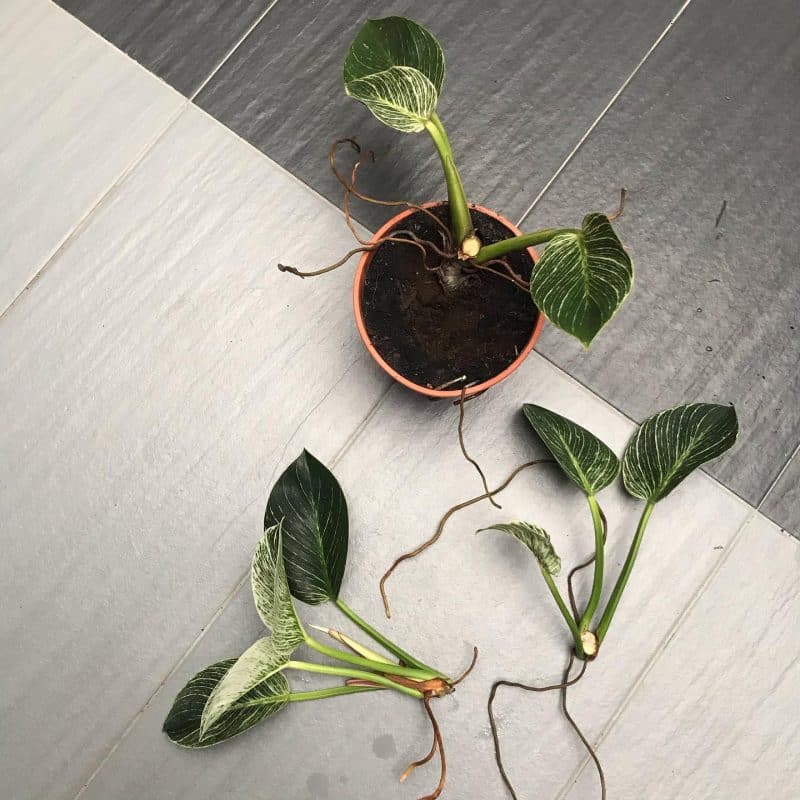
Now let’s cover how to tackle some of the most common issues your Philodendron birkin might experience, including curled leaves, yellow or brown leaves, and stem damage.
Common issues
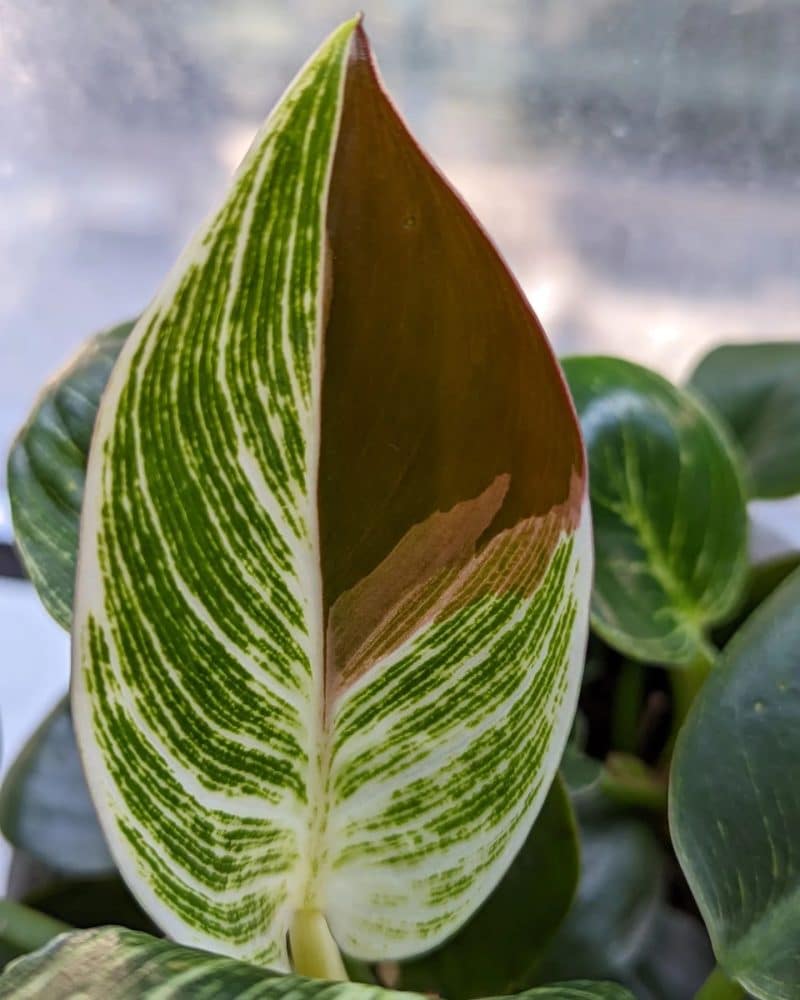
Some unusual characteristics of a healthy Philodendron birkin might seem like problems at first. For instance, its lower leaves will lose their stripes over time. This is totally expected!
New white leaves are also normal for this plant. The telltale Philodendron birkin variegation comes through as the leaf grows. Its white leaves will change to a dark green with white stripes over time.
- Curled leaves. This is a sign your plant is too cold. The Philodendron birkin is tropical, so if temperatures are too low, or it’s placed near a drafty window or vent, its leaves will start curling inward. Move to your plant to a warmer location or increase the temperature in its current environment.
- Damage to stem. Mushy or weak Philodendron birkin stems are caused by overwatering or poorly draining soil. Let the soil dry out completely between waterings, and make sure its soil mix drains well to prevent root rot. Adding sphagnum moss to the potting soil you’re currently using is one way to increase drainage.
- Yellow leaves. A yellow Philodendron birkin leaf is either due to overwatering or old age. If yellow leaves are at the bottom of the plant and have faded from a dark green, it’s a natural occurrence and no cause for alarm. If newer Philodendron birkin leaves are turning yellow, though, make sure the soil is dry one or two inches down before watering.
- Brown leaves. Brown or crispy leaves indicates your Philodendron birkin is too dry and needs more humidity. Consider using a humidifier or a pebble tray.
Diseases and pests
Philodendron birkin are especially susceptible to spider mites. They can also attract the usual pests, like scale, aphids, mealybugs, and fungus gnats.
If you notice any spider mites or other insects on your plant, no need to panic. To get rid of these unwanted visitors, use a 50% diluted neem oil spray around stems and on the tops and undersides of all leaves.
Conclusion
Philodendron birkin is the perfect plant for those who like surprises. It’s a mutated hybrid with variegated leaves that can grow from white to green with white stripes, or sometimes appear in red and cream hues. It might even start to revert, creating a unique mix of solid and striped leaves.
Care for a Philodendron birkin isn’t difficult. As a tropical plant, it grows best in bright, indirect light with at least 60% humidity and household temperatures between 65-75 degrees Fahrenheit. Propagate it with stem cuttings and enjoy watching its unique leaf patterns develop.
FAQ
Is a Philodendron birkin rare?
The Philodendron birkin isn’t rare in the traditional sense, since it’s well-stocked in nurseries and plant stores. It is rare in the sense that you won’t see it growing in the wild, since it has to be cultivated by tissue.
Do Philodendron birkin plants like to be misted?
Since these plants are tropical, they do enjoy being misted to boost their humidity. Mist up to two times a day in the growing months, but only once or twice a week during the fall and winter. Just make sure you aren’t soaking the Philodendron birkin and its soil, since overwatering is a big no-no for philodendron in general.
Do Philodendron birkin revert colors? What do I do if it’s producing too many white leaves?
Philodendron birkins can, but don’t always, revert to a Philodendron Rojo Congo, the plant they originally mutated from. If this happens, you’ll start seeing solid red and cream-colored leaves. Check the “Soil and planting” section above for more information about how to fix this.
If the older leaves are turning white, this is a sign the plant is reverting. You don’t have to do anything about new white leaves, though, since they’re a normal part of the plant’s lifecycle and will eventually turn green with white stripes. This video is a good example of what that process looks like.
How big does a Philodendron birkin get?
This plant can grow anywhere from 1.5 to over 3 feet tall. In the growing season, its leaves can grow over four inches a week, so save space!
Does a Philodendron birkin climb?
The Philodendron birkin doesn’t climb or vine, but it can lean to one side. You can support the Philodendron birkin by letting its aerial roots grow around a moss pole.

